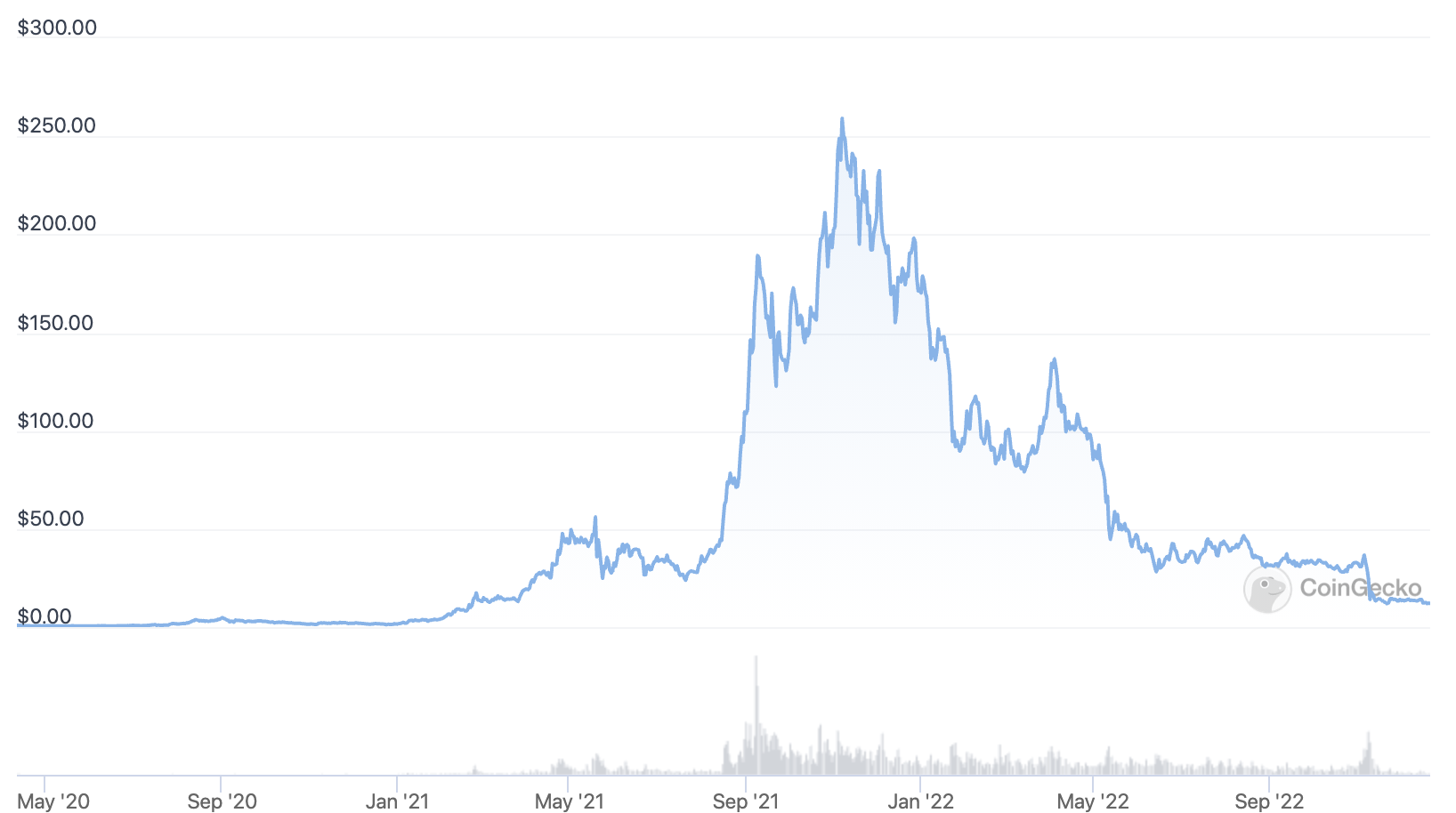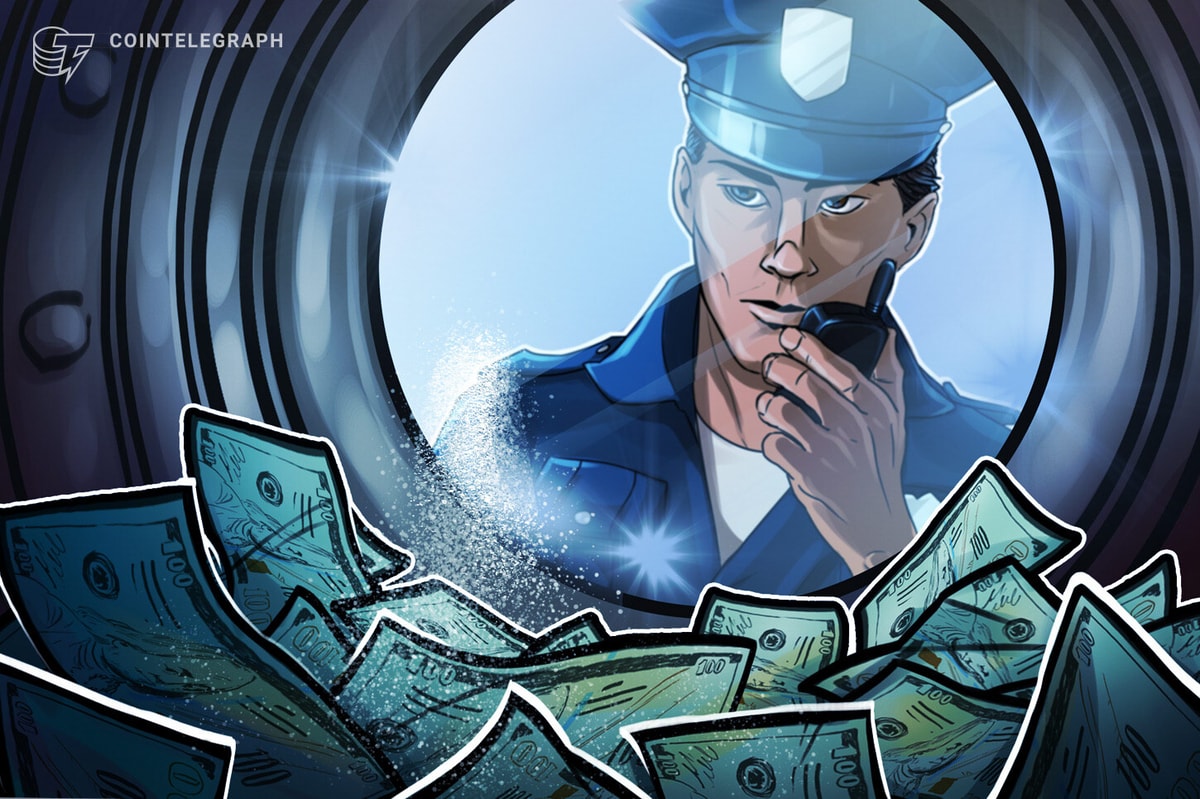Solana became one of the stars of cryptocurrency in 2021, climbing an eye-watering 3,700% at its peak before struggling amidst market-wide corrections.
At the core of Solana’s widely-documented rise to prominence was the promise of unrivaled utility, posing a direct threat to the dominance of Ethereum’s blockchain network, which has long stood as the favored place for developers to launch decentralized finance (DeFi) projects and applications.
But could Solana overtake Ethereum to become the number one DApp blockchain? Potentially, yes, and here are five reasons why.
Solana vs. Ethereum Price
The harsh corrections of 2022 sent Solana and Ethereum’s networks tumbling, with SOL retracing some 95% compared to ETH’s 75% pullback from respective all-time highs.
As CoinGecko data shows, SOL’s deeper pullback is down, in no small part, to the sheer scale of its price accumulation in 2021. Buoyed by many influential cheerleaders, SOL soared from a value of $1.54 on December 31st, 2020, to a peak of $259.96 by November 4th, 2021; a remarkable rally by all accounts.
At the core of the great levels of investor interest in SOL is Solana’s highly functional blockchain, which has made the network an excellent space for the buying and selling of NFTs as well as hosting other high-quality Dapps.
It’s this level of utility that has led some commentators to label Solana an “Ethereum killer,” but could this really be the case? Let’s look at five reasons why Solana could overtake Ethereum as the king of NFTs.
5 Reasons Solana Can Overtake Ethereum
Launched in early 2020 by two former Qualcomm engineers, Solana hosts a fast and low-cost blockchain that makes for the perfect home to many DeFi platforms and Dapps, including NFT marketplaces.
Significantly, Solana has a “Proof-of-History” consensus that establishes the order of transactions. Rather than relying on validators to confirm transaction times, proof-of-history can offer more security and flexibility for developers and validators alike to make faster transactions.
Furthermore, Solana utilizes Cloudbreak as a form of distributed archive that can prevent transaction history from taking up masses of computing space and slowing down the network.
Built with functionality in mind, Solana isn’t designed to be a store of wealth like Bitcoin and has been developed to help the cryptocurrency ecosystem thrive faster than Ethereum allows. But will this be enough to topple the dominance of Ethereum in the DeFi space?
1. Revolutionary Proof-of-History Consensus
As we’ve already touched on, Solana’s Proof-of-History consensus is cutting-edge within the cryptocurrency landscape, and the approach has won the network plenty of admirers from across the ecosystem.
This is because many programmable blockchains like Ethereum depend on outside programs to add a “median” timestamp to transactions to validate them in the order that they’ve been received.
Solana argues that this incorporates unnecessary levels of centralization in a system that’s supposed to be fully decentralized (although there are still valid questions raised over SOL’s own decentralized structure). It’s through the revolutionary Proof-of-History consensus that Solana can place these timestamps within the blockchain itself via a variable delay function (VDF).
“Every block producer has to crank through the VDF, this proof of history, to get to their assigned slot and produce a block,” explains Anatoly Yakovenko, co-founder of Solana Labs, adding that this approach “gives the ledger this interesting property where you can infer when events occurred when you examine it.”
2. Rapid Transactions
One of Solana’s key advantages compared to Ethereum is that it doesn’t have a waiting period between processing a transaction and confirming it on the blockchain. While Solana transactions are capable of being accepted almost instantly, Ethereum’s waiting period generally spans around four minutes.
Because transactions require less time to process, Solana is a more eco-friendly solution in comparison to Ethereum’s gas-hungry blockchain, making the efficiency of SOL even more attractive than its predecessor.
NFT creators and buyers alike have been lured in by the appeal of faster transaction times and more responsive marketplaces, which have played a significant role in Solana overtaking Ethereum in NFT trading volume for the first time in May 2022.
3. Minimal Transaction Fees
Speaking of Ethereum’s gas-hungry nature, processing transactions on its congested network requires costly fees that can fluctuate towards over $100 per transaction. Furthermore, purchasing a single NFT could cost buyers as much as $250 simply to make the transaction work. The more complex a transaction on Ethereum’s blockchain, the more costly it is.
As the cryptocurrency ecosystem cooled in 2022 and the rollout of Ethereum 2.0 took place, Ethereum’s gas prices have fallen. However, they still don’t come close to the ultra-low costs of Solana, which has an average cost-per-transaction of $0.00025.
These relatively minuscule fees empower NFT collectors to pay for the artworks and collectibles they want without losing money by fuelling the transaction itself.
4. Solana Is Gaining Momentum Over Ethereum
Another key factor behind Solana’s case for overtaking Ethereum is the sheer level of momentum generated by the network and its native cryptocurrency, SOL.
In the five weeks that followed the launch of Solana, between August 1st and September 7th, 2020, SOL rose some 428.32%. By its peak in November 2021, Solana reached a market capitalization of $63 billion, and the cryptocurrency became a mainstay in the top 10 based on market cap.
This rise to prominence has been a strong show of faith in the underlying technical framework of Solana. Although SOL has struggled amidst wider market downturns, momentum during the next bull market could flow to Solana again rather than staying with old favorites like Ethereum.
5. Superior Utility
Finally, Solana bills itself as a “Web3 infrastructure for everyone”, and its underlying numbers show that this could well be the case as the next generation of the internet continues to build momentum.
At present, over 21 million NFTs have been minted on Solana’s network, and its blockchain has seen more than 125 billion transactions take place, all on a platform that didn’t exist before 2020.
Despite taking a significant hit amidst widespread market turbulence, Solana remains a leading star in terms of bringing greater utility and flexibility to the cryptocurrency landscape and may well become the undisputed leader when it comes to the buying, selling, and minting of non-fungible tokens.
Could Solana’s NFTs Overtake Ethereum?
There are certainly some caveats to counter for Solana, and its network has been vulnerable to security breaches, and new rivals are continuing to emerge as contenders. However, there’s little doubting the pragmatism of its blockchain.
Ethereum is still the star of DeFi at present, but major cryptocurrency market crashes and crypto winters like the one we’re enduring today can give rise to new and worthy projects. Should the NFT landscape use the downturn to reconsider their allegiances to Ethereum, we may well see a new spell of dominance for Solana emerging in 2023 and beyond.
Read More: news.google.com











 Bitcoin
Bitcoin  Ethereum
Ethereum  Tether
Tether  XRP
XRP  Solana
Solana  USDC
USDC  Dogecoin
Dogecoin  Cardano
Cardano  TRON
TRON  Lido Staked Ether
Lido Staked Ether  Wrapped Bitcoin
Wrapped Bitcoin  Sui
Sui  Wrapped stETH
Wrapped stETH  Chainlink
Chainlink  Avalanche
Avalanche  Stellar
Stellar  Hyperliquid
Hyperliquid  Shiba Inu
Shiba Inu  Hedera
Hedera  LEO Token
LEO Token  Bitcoin Cash
Bitcoin Cash  Toncoin
Toncoin  Litecoin
Litecoin  Polkadot
Polkadot  USDS
USDS  WETH
WETH  Monero
Monero  Bitget Token
Bitget Token  Binance Bridged USDT (BNB Smart Chain)
Binance Bridged USDT (BNB Smart Chain)  Wrapped eETH
Wrapped eETH  Pepe
Pepe  Pi Network
Pi Network  Ethena USDe
Ethena USDe  Coinbase Wrapped BTC
Coinbase Wrapped BTC  WhiteBIT Coin
WhiteBIT Coin  Bittensor
Bittensor  Uniswap
Uniswap  Dai
Dai  Aave
Aave  NEAR Protocol
NEAR Protocol  Aptos
Aptos  OKB
OKB  Jito Staked SOL
Jito Staked SOL  Ondo
Ondo  Cronos
Cronos  BlackRock USD Institutional Digital Liquidity Fund
BlackRock USD Institutional Digital Liquidity Fund  Internet Computer
Internet Computer  Tokenize Xchange
Tokenize Xchange